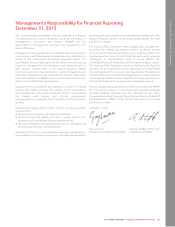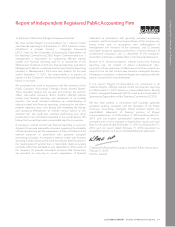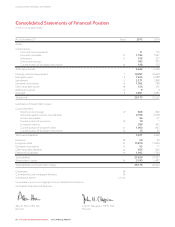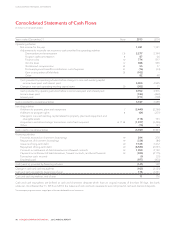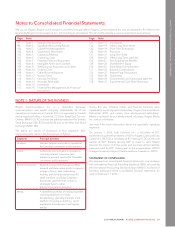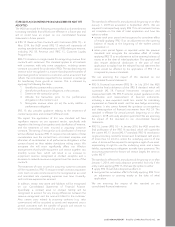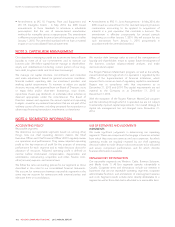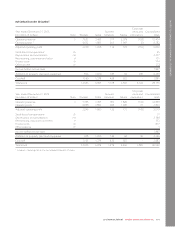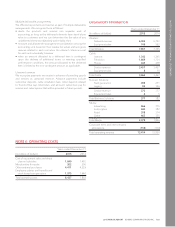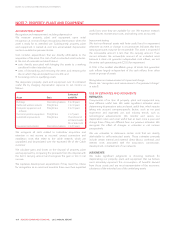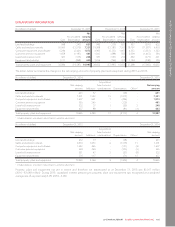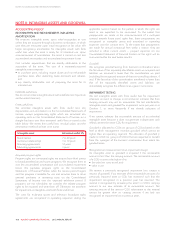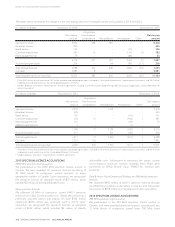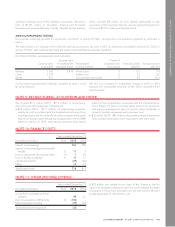Rogers 2015 Annual Report Download - page 101
Download and view the complete annual report
Please find page 101 of the 2015 Rogers annual report below. You can navigate through the pages in the report by either clicking on the pages listed below, or by using the keyword search tool below to find specific information within the annual report.
NOTES TO CONSOLIDATED FINANCIAL STATEMENTS
(f) RECENT ACCOUNTING PRONOUNCEMENTS NOT YET
ADOPTED
The IASB has issued the following new standards and amendments
to existing standards that will become effective in a future year and
will or could have an impact on our consolidated financial
statements in future periods:
• IFRS 15, Revenue from Contracts with Customers (IFRS 15) – In
May 2014, the IASB issued IFRS 15 which will supersede all
existing standards and interpretations in IFRS relating to revenue,
including IAS 18, Revenue and IFRIC 13, Customer Loyalty
Programmes.
IFRS 15 introduces a single model for recognizing revenue from
contracts with customers. This standard applies to all contracts
with customers, with only some exceptions, including certain
contracts accounted for under other IFRSs. The standard requires
revenue to be recognized in a manner that depicts the transfer of
promised goods or services to a customer and at an amount that
reflects the consideration expected to be received in exchange
for transferring those goods or services. This is achieved by
applying the following five steps:
1. Identify the contract with a customer;
2. Identify the performance obligations in the contract;
3. Determine the transaction price;
4. Allocate the transaction price to the performance
obligations in the contract; and
5. Recognize revenue when (or as) the entity satisfies a
performance obligation.
IFRS 15 also provides guidance relating to the treatment of
contract acquisition and contract fulfillment costs.
We expect the application of this new standard will have
significant impacts on our reported results, specifically with
regards to the timing of recognition and classification of revenue,
and the treatment of costs incurred in acquiring customer
contracts. The timing of recognition and classification of revenue
will be affected because IFRS 15 requires the estimation of total
consideration over the contract term at contract inception and
allocation of consideration to all performance obligations in the
contract based on their relative standalone selling prices. We
anticipate this will most significantly affect our Wireless
arrangements that bundle equipment and service together into
monthly service fees, which will result in an increase to
equipment revenue recognized at contract inception and a
decrease to network revenue recognized over the course of the
contracts.
The treatment of costs incurred in acquiring customer contracts
will be impacted as IFRS 15 requires certain contract acquisition
costs (such as sales commissions) to be recognized as an asset
and amortized into operating expenses over time. Currently,
such costs are expensed as incurred.
In addition, certain new assets and liabilities will be recognized
on our Consolidated Statements of Financial Position.
Specifically, a contract asset or contract liability will be
recognized to account for any timing differences between the
revenue recognized and the amounts billed to the customer.
Also, certain costs related to acquiring contracts (e.g. sales
commissions) will be recorded as assets and expensed over a
period consistent with the transfer of goods and services to
which the asset relates, instead of as incurred.
The standard is effective for annual periods beginning on or after
January 1, 2018 (as amended in September 2015). We are
required to retrospectively apply IFRS 15 to all contracts that are
not complete on the date of initial application and have the
option to either:
• restate each prior period and recognize the cumulative effect
of initially applying IFRS 15 as an adjustment to the opening
balance of equity at the beginning of the earliest period
presented; or
• retain prior period figures as reported under the previous
standards and recognize the cumulative effect of initially
applying IFRS 15 as an adjustment to the opening balance of
equity as at the date of initial application. This approach will
also require additional disclosures in the year of initial
application to explain how the relevant financial statement line
items would be affected by the application of IFRS 15 as
compared to previous standards.
We are assessing the impact of this standard on our
consolidated financial statements.
• IFRS 9, Financial Instruments (IFRS 9) – In July 2014, the IASB
issued the final publication of the IFRS 9 standard, which will
supersede IAS 39, Financial Instruments: recognition and
measurement (IAS 39). IFRS 9 includes revised guidance on the
classification and measurement of financial instruments,
including a new expected credit loss model for calculating
impairment on financial assets, and the new hedge accounting
guidance. It also carries forward the guidance on recognition
and derecognition of financial instruments from IAS 39. The
standard is effective for annual periods beginning on or after
January 1, 2018, with early adoption permitted. We are assessing
the impact of this standard on our consolidated financial
statements.
• IFRS 16, Leases (IFRS 16) – In January 2016, the IASB issued the
final publication of the IFRS 16 standard, which will supersede
the current IAS 17, Leases (IAS 17) standard. IFRS 16 introduces a
single accounting model for lessees and for all leases with a term
of more than 12 months, unless the underlying asset is of low
value. A lessee will be required to recognize a right-of-use asset,
representing its right to use the underlying asset, and a lease
liability, representing its obligation to make lease payments. The
accounting treatment for lessors will remain largely the same as
under IAS 17.
The standard is effective for annual periods beginning on or after
January 1, 2019, with early adoption permitted, but only if the
entity is also applying IFRS 15. We have the option to either:
• apply IFRS 16 with full retrospective effect; or
• recognize the cumulative effect of initially applying IFRS 16 as
an adjustment to opening equity at the date of initial
application.
We are assessing the impact of this standard on our
consolidated financial statements.
2015 ANNUAL REPORT ROGERS COMMUNICATIONS INC. 99


